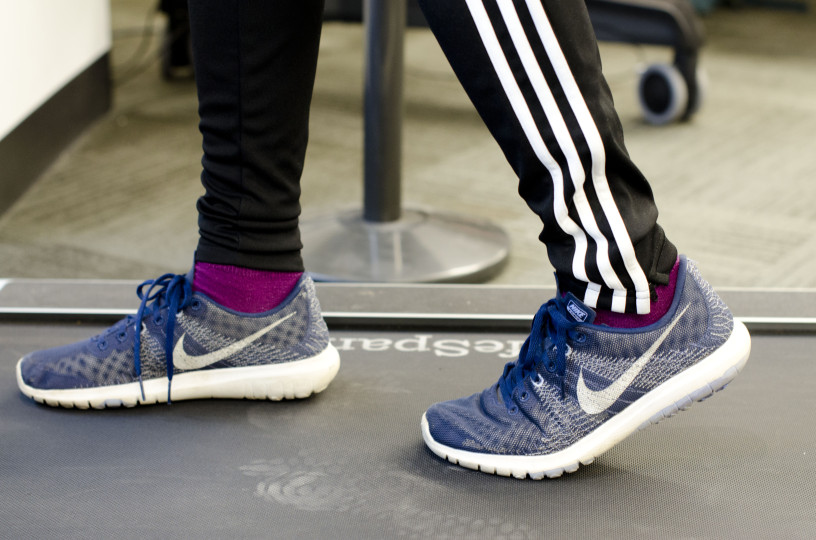After a month and a half of regular exercise—swimming, going to the gym, and the occasional run—I was hit in the leg with not one, not two, but three on-and-off injuries. All that training came to a crashing halt, along with my plans to compete in my first triathlon this June.
I’ll spare you the (painful) details for now, but basically I have knee pain—colloquially referred to as “runner’s knee” —shin splints, and occasional pain through my heel and achilles tendon. The knee pain is something I’ve been dealing with on-and-off since April, so it’s not really a surprise it reappeared. The other injuries, however, are brand new and typically caused by overuse.
I was finally feeling back on track after months of tiptoeing around workouts, cautious that a few days later I would wake up to a throbbing knee. Although I still haven’t signed up for that triathlon, in fear I’ll be in too much pain to train, it’s still my goal.
While I’m not a sports injuries professional, as someone who has always been involved in sport, I’ve had my fair share of injuries. So here are my tips for rest and recovery to get back to the track, pool, gym, or whatever:
- Rest. Seriously, don’t try to train through the pain. I tried this not too long ago, and let me tell you, it didn’t go over well. I figured I could just run through the pain, but it ended in tears (more so from frustration than pain) and more pain than when I started out with that first lap around the track. I know how tough it is to stop exercising—this mental struggle can be more overwhelming than the injury—but it’s the only way to avoid exacerbating the pain. Then, when you’re ready to go again, don’t resume training full speed right away.If you don’t give your body a chance to warm up to a training regime, it can cause overuse injuries like shin splints.
- Go see a doctor (and actually listen to them). Most general practitioners will give you some tips for relieving your pain. Plus, if you want to see a physiotherapist, chiropractor, or another specialist about your injury, many insurance providers require a doctor’s note for treatment. The most important piece of advice here is to listen to the professional. If they tell you to rest, rest. If they say to ice, ice. And if you are prescribed strengthening exercises by a physiotherapist, do them! For so long, I never did the exercises prescribed to me by doctors, physiotherapists, or chiropractors. Now I have to face the consequences and be on a longer road to recovery. If you’re planning on seeing a specialist, I’ve personally found that active release therapy has been more helpful in treating my injuries over the years than physiotherapy—but your doctor will know the best option for you.
- Stretch and foam roll. For me, especially, I’ve learned my injuries are triggered by tight calves and IT bands, meaning that I need to loosen up the muscles in order to return to pain-free activity. I stretch before and after every workout (or at least try to), holding stretches for at least 30 seconds, and doing a few varieties for each major muscle group. Foam rolling is also a good practice post-workout. I have both a large roller and a hand-held one to help aid in muscle recovery. You can find plenty of great guides in a quick Google search like this one that tells you all about the benefits of foam rolling, and this video that shows you how to roll out your whole body.
- R.I.C.E. I’m sure you’ve heard of this basic acronym used to teach first aid: Rest, immobilize, cold compress, elevate. Although it’s taught in relation to bone and joint injuries, it can be easily applied to simple muscle recovery. We’ve already covered the importance of resting, and immobilizing is similar—depending on the injury, wear a brace if you have one or use a tensor bandage to reduce the strain on your body. Finally, ice the injury to reduce inflammation and swelling, and if the injury is on your lower body, elevate it to increase blood flow to the area. Personally, I’ve gotten in the habit of icing my injuries at the end of most days. It may not feel like it’s doing much to help, but it is crucial in the early stages of many injuries.
- Don’t forget about your mental health. As someone who relies on exercise to stabilize my mental health, I can’t overemphasize how much these injuries have, in past and present, affected my mental well-being. For example, last April when I was first dealing with the knee injury, it was right around the time where the winter snow had melted—perfect spring running weather. Every time I walked outside, I would see at least one person out for a run. But I couldn’t run. And it killed me. It’s absolute mental torture—that’s the best way I can describe it—to see others doing what you physically can’t do pain-free, but know you’re capable of. So take care of your mental health by talking to someone, or at least finding exercise you can do—even if you’re just focusing on simple strength training exercises like planks, or cross-training with a low-impact exercise like swimming.
Yes, injuries suck. They’re frustrating. But it sucks more to be out of commission for longer because you haven’t taken care of yourself.
Here’s hoping for pain-free workouts and a triathlon this June—or whatever you’re training for!






